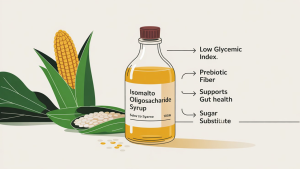Isomalto Oligosaccharide Powder: A Balanced Prebiotic Fiber for Sugar-Controlled Functional Formulations

Among the many prebiotic fibers we’ve reviewed recently, Isomalto Oligosaccharide (IMO) powder stands out as a well-rounded option for formulators who are navigating the tightrope between taste, blood sugar management, and clean labeling. Derived primarily from enzymatically processed starches (usually corn or rice), IMO combines low glycemic response with mild sweetness, making it a versatile ingredient across different product categories.
Compared to inulin or FOS, Isomalto Oligosaccharide tends to be easier on the gut and cleaner on the palate—something you start to appreciate when scaling up RTD formulations or high-fiber bakery lines. We’ve found it especially useful where a smooth mouthfeel matters and where every line on the ingredient label gets scrutinized.
Who Should Consider It?
If you’re working on:
- Sugar-conscious nutritional products
- Prebiotic-enhanced functional foods
- Alternative sweeteners with added fiber claims
then IMO powder is well worth your attention.
As a non-digestible carbohydrate, IMO bypasses small intestine absorption and reaches the colon intact, where it can serve as a substrate for beneficial gut bacteria like Bifidobacteria and Lactobacillus. A 2020 study in Food Chemistry confirmed IMO’s capacity to stimulate bifidobacterial growth, supporting gut health and metabolic balance.
On top of that, IMO has a significantly lower glycemic index than traditional sugars. In our in-house prototype testing, it effectively reduced the sugar load in the final formulation without compromising on taste—a win for formulators targeting the growing “low-GI” market.
Three Reasons IMO Works Well in Real-World Formulation
1. Subtle Sweetness That Blends Easily
IMO has a clean, maltose-like sweetness—not too overpowering, not too bland. It avoids the lingering bitterness sometimes found in inulin or stevia derivatives, making it especially useful in nutrition bars, plant-based shakes, and fiber-enriched bakery items.
In one test, we added 3% IMO to a high-protein snack bar formula. The result? Noticeably smoother texture and better palatability, with reduced protein powder aftertaste.
2. Low Glycemic Impact, High Digestive Tolerance
This is where IMO really differentiates itself. While other prebiotics like FOS and inulin are known to cause bloating at higher dosages, IMO remains relatively digestively gentle—even at usage levels of 5g per serving.
According to EFSA’s technical assessment, IMO is not classified as a sugar alcohol, making it easier to integrate into products for diabetic or blood-sugar-sensitive consumers.

3. Formulation-Friendly: High Solubility, Neutral Color, Excellent Stability
In powder form, IMO dissolves quickly in water (≥99% solubility) and contributes no odor or visual turbidity. We’ve tested it in both ready-to-mix beverages and plant-protein blends, and it integrates smoothly, even improving mouthfeel slightly by reducing watery textures.
Its heat resistance also makes it a practical option in baked goods, where some oligosaccharides may degrade or caramelize.
Technical Highlights at a Glance
| Specification | Value | Notes |
| Appearance | White powder | Neutral, low sweetness |
| Total IMO Content | ≥90% (dry basis) | High purity |
| IG2 + P + IG3 | ≥45% | Key prebiotic compounds |
| Solubility | ≥99% | Fully water-soluble |
| pH Range | 4.0 – 6.0 | Food-safe and stable |
| Heavy Metals | Pb ≤ 0.5 mg/kg, As ≤ 0.5 mg/kg | Compliant with food-grade standards |
Syrup format (75% solids, ≥95% light transmittance) is also available for transparent beverages and liquid applications.
Where Does IMO Sit Among Other Prebiotics?
| Attribute | IMO | FOS | Inulin | GOS |
| Glycemic Impact | Very low | Low | Low | Moderate |
| Taste | Neutral-sweet | Mild | Slight bitterness | Sweet |
| Digestive Tolerance | High | Medium | Low (bloating risk) | Medium |
| Processing Adaptability | High | Medium | Low (hygroscopic) | High |
| Sweetener Functionality | Yes | No | No | No |
IMO offers one of the most balanced profiles: sweet but not too sweet, gut-friendly without discomfort, and easy to incorporate across product types.
Ideal Use Cases We Recommend
- Functional snack bars and meal replacements looking for a “prebiotic + sugar-reduction” combo
- Ready-to-drink products (dairy and plant-based) needing mild sweetness and stable fiber claims
- Low-GI baked goods seeking a functional sweetener that also improves moisture retention
Sourcing Tips: What to Look For in a Good IMO Supplier
When selecting IMO as a functional ingredient, pay attention to:
- ≥90% IMO content with ≥45% IG2 + P + IG3
Ensures real prebiotic performance, not just filler carbs. - Clean-label compliance
No added sugars, no artificial flavors, preservatives, or processing aids. - Documentation availability
COAs, 3rd-party lab reports for heavy metals, microbial safety, and sugar profiles.
We work with certified manufacturers (ISO, HACCP) that can offer custom powder or syrup specs, OEM blending, and bulk support depending on your formulation needs.
Why It Aligns with Future Formulation Trends
With increasing regulatory pressure on sugar reduction and rising consumer interest in gut health, multi-functional fibers like IMO are gaining traction. According to a 2023 report from Innova Market Insights, product launches with prebiotic claims grew 22% YoY, with a clear tilt toward ingredients that combine health benefits with sensory performance.
IMO fits squarely into this niche. It offers both function and form—helping brands meet fiber targets, reduce added sugar, and appeal to consumers looking for clean, digestive-friendly labels.
Regulatory and Labeling Considerations
IMO is generally recognized as safe (GRAS) in the U.S. and is also compliant with EU regulations under the classification of non-digestible carbohydrates. In markets like Japan and Korea, IMO has long been used in health-oriented products, including FOSHU-labeled items.
From a labeling standpoint, IMO can often be declared as “Isomalto-oligosaccharide,” “prebiotic fiber,” or “dietary fiber,” depending on jurisdictional guidelines. Its dual function as a fiber and a mild sweetener makes it especially appealing for markets with strict sugar labeling thresholds.
We’ve seen our share of prebiotic fibers, and Isomalto Oligosaccharide Powder isn’t trying to be the most headline-grabbing one. But in terms of formulation ease, digestive tolerance, and technical reliability, it consistently delivers. It’s the kind of ingredient that does its job—quietly, effectively, and without drama. If that’s what your product line needs, it’s worth a closer look.
Want a spec sheet or sample?
Contact our formulation support team for technical documents, usage guidance, or supply chain options tailored to your project.
References
Related recommendations
-
Fructo-Oligosaccharide Powder: Health Benefits and Uses
852Discover What Fructo-Oligosaccharide Powder Is, Its Health Benefits, And Common Uses In Food And Supplements-SGNUTRI.
View details -
Is Maltitol Syrup Gluten Free? A Comprehensive Guide
881Maltitol Syrup Is A Gluten-Free Sweetener Used In Sugar-Free Foods. Learn What It Is And Why Sgnutri Recommends It.
View details -
Isomalto Oligosaccharide Syrup: Versatile Prebiotic
818Support Digestion And Wellness With Sgnutri's Imo Syrup – Ideal For Health Foods And Functional Beverages.
View details -
Is Maltitol Syrup Gluten Free? Everything You Should Know
353Find out if maltitol syrup is gluten-free, its uses as a sweetener, and whether it’s safe for people with gluten sensitivity.
View details
 SGNUTRI
SGNUTRI



